There have been six further Covid-19 related deaths and 772 new cases of the disease notified to the Department of Health in the past 24 hours.
There has been a total of 1,908 coronavirus-related deaths in Ireland. The total number of cases is 61,059. This includes the denotification of 10 previously confirmed cases.
The number of people in ICU is 42, a decrease of one since yesterday. There are 325 patients with the virus in hospitals as of 2pm today, with 15 additional hospitalisations in the past 24 hours.
Case numbers had been increasing since June but have started to reduce over the last week for the first time.
The R (reproductive) number is now estimated to be close to 1.
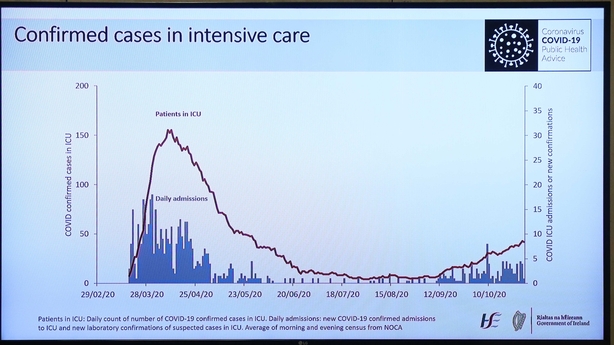
Chief Medical Officer, Dr Tony Holohan, said: "The overall situation has improved, but we have to remember that these are very early days. This improvement will only be maintained if we keep going in our efforts.
"We have to remember that incidence is increasing in older age groups, who are particularly vulnerable to this disease. The way in which we can protect them is if we continue to drive down transmission across the whole population."
Substantial reduction of Covid-19 in 19-24 age group but an increase in the over 65s age group, says Chief Medical Officer Dr Tony Holohan ¦ Read more: https://t.co/WfVml8OKtd pic.twitter.com/ooxbcY9p4T
— RTÉ News (@rtenews) October 30, 2020
Professor Philip Nolan, chair of the National Public Health Emergency Team's (NPHET) Irish Epidemiological Modelling Advisory Group, said: "The reproduction number is now close to 1 nationally.
"This is the first time in a number of weeks that we have been able to report positive indicators of the disease.
We would be estimating a 3% reduction per day in cases over the last 14 days, says Professor Philip Nolan ¦ Read more: https://t.co/WfVml8OKtd pic.twitter.com/JmbZchkc8p
— RTÉ News (@rtenews) October 30, 2020
"However, our experience to date shows this type of progress is very fragile.
"We should take these positive signs as an indication our efforts are starting to work, the critical thing now is to keep it up, the virus will seek out any opportunity to spread.
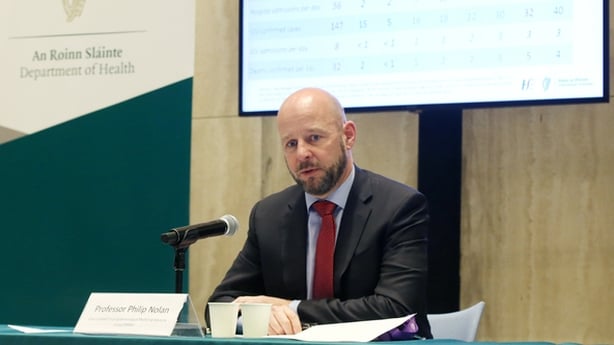
"Over the next weeks, let's make sure we don't give it that opportunity, by driving R and case numbers as low as possible. This is not the time to relax."
There are positive indications that we are starting to suppress the virus but it is clear that position is fragile, says Professor Philip Nolan ¦ Read more: https://t.co/WfVml8OKtd pic.twitter.com/9vmqy9SEpZ
— RTÉ News (@rtenews) October 30, 2020
Prof Nolan said the number of cases being confirmed each day is reducing.
"We peaked last week with a seven-day average of close to 1,200 cases per day. Today, that number is 836," he said.
The 14-day incidence peaked at around 310 and is now at 287. "This indicates a real decrease in the rate of transmission," he said.
Prof Nolan said the positivity rate was also declining, from a recent peak of 7.9% to a current rate of around 5.3%. However, you have to be "quite careful" about this figure, he said.
Prof Nolan said the Level Five restrictions introduced on 21 October are only starting to have an effect on reported cases.
He said: "In about ten days time... we'll have a much clearer picture of whether we are on track... but frankly we're not going to know until three or probably four weeks into the six week period what trajectory we are following because of the lag between when people change their behaviour and when infections actually occur."
There was a mixture of reasons for people getting tested, however "at least some of that reduction in positivity rate is real and due to a reduction in the underlying level of infection, but not all of that reduction is real."
Prof Nolan said there was a narrative that "somehow the virus is less virulent than it was or less fatal than it was, or that we overestimated its fatality in the past". However, "neither of those things are true".
All the evidence that we have shows low evidence of transmission of Covid-19 in schools, says Chief Medical Officer Dr Tony Holohan¦ Read more: https://t.co/WfVml8OKtd pic.twitter.com/ykqr4xEOjS
— RTÉ News (@rtenews) October 30, 2020
He said only severe cases were being detected in March and April and for every case that was detected, there were two that were not picked up due to the testing capacity.
"If you compare fatality rates back then with now, you'd expect fatality rates to be about a third of what they were because we have these extra cases that we are detecting now," Professor Nolan said.
"It continues to be a virus as dangerous as it always was, at the same rates as it always was, the only difference is that we are picking up all the milder asymptomatic cases now, and they are important because they spread the disease."
Prof Nolan said the average number of close contacts for every positive case was as high as six and is now closer to two, showing people were changing their behaviour.
Dr Tony Holohan told reporters that an "enormous amount of work" has been done across the education sector to get schools reopened.
He said: "All the evidence we have shows that the experience we are having in schools is as expected - there are low levels of transmission."
Deputy Chief Medical Officer Dr Desmond Hickey said: "As of today, Ireland has seen a reduction in its seven-day incidence rate of 36% when compared to the previous seven days."
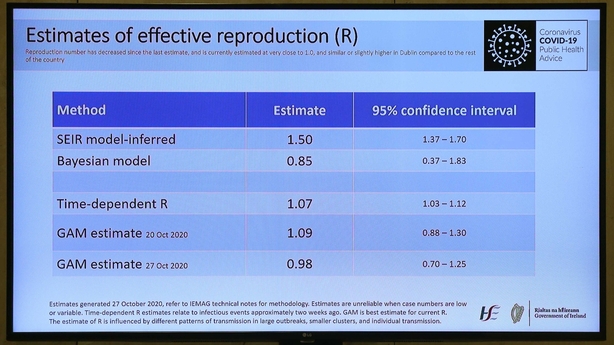
The national 14-day incidence rate is 287.1 per 100,000 and counties with the highest number of Covid-19 cases include Cavan (669.5), Meath (546.5), Westmeath (413.4) and Sligo (363.2).
Counties with the lowest rates include Leitrim (121.7), Tipperary (132.2), Wicklow (139.7) and Kilkenny (151.2).
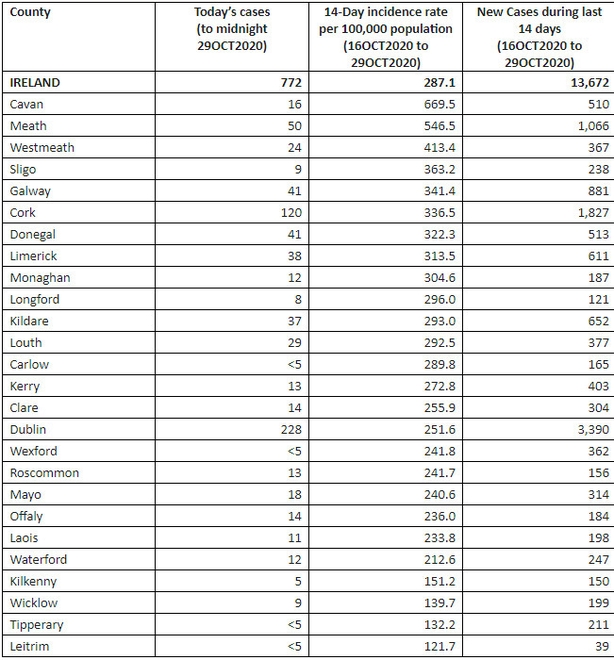
Dr Hickey said Ireland was one of only four countries in Europe where there was a decrease in the seven-day incidence rate per 100,000 population in the week up to the 30 October, compared with the previous week.
He said: "Ireland's progress is notable when compared to the rapidly deteriorating picture across Europe. It is paramount that we sustain and continue to drive down disease incidence as much as possible in the coming weeks."
Interactive map: Covid-19 cases in your area
Dr Hickey said the European Centre for Disease Control (ECDC) has classified the majority of countries in Europe as experiencing an "epidemiological situation of serious concern".
He said testing positivity in these countries has been increasing since August - pointing to a real increase in virus transmission.
With high levels of community transmission, it is difficult to protect the vulnerable and this was a message NPHET has been keen to stress.
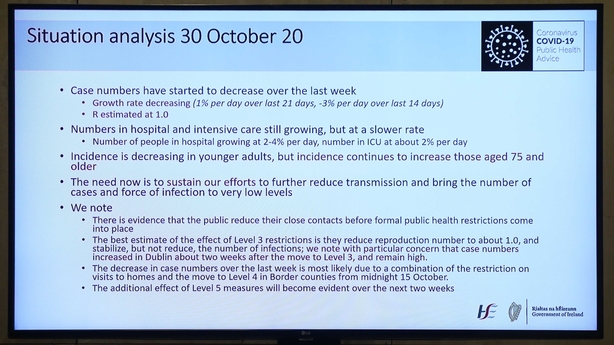
Dr Hickey added that many countries across Europe are witnessing rising death rates.
In Ireland, we are also continuing to see an increase in mortality - so far in October, 96 people with Covid-19 have died with 34 of those in nursing homes.
This compares with a total of 36 deaths in people with Covid-19 in September and five in August.
Dr Holohan said the "best means we have of offering protection to nursing homes and people in vulnerable groups is to arrest the growth of community transmission".
HSE Chief Clinical Officer Dr Colm Henry said: "There has been a significant reduction in emergency presentations and admission in recent weeks, when compared with activity last year."
The number of people presenting to A&E is down by over 16% and in over 75s, it is 18% lower than normal for this time of year.
He said: "Our message is that our emergency departments are currently safe, our hospitals are currently stable. If you need care you can come to hospitals... this care can be provided safely."
Our hospital situation is currently stable, says Dr Colm Henry ¦ Read more: https://t.co/WfVml8OKtd pic.twitter.com/ISJNIR2TS0
— RTÉ News (@rtenews) October 30, 2020
Dr Henry said that while the hospital system "is currently stable", the experience in Europe was a reminder that we are "only ever a few weeks away from healthcare systems becoming overwhelmed"'
Of the cases notified today, 64% are under 45 years of age with 228 in Dublin, 120 in Cork, 50 in Meath, 41 in Donegal, 41 in Galway and the remaining 292 cases are spread across all remaining counties.
Deputy Chief Medical Officer Dr Desmond Hickey says an ECDC rapid risk assessment has highlighted the worsening Covid-19 situation across Europe ¦ Read more: https://t.co/WfVml8OKtd pic.twitter.com/xZ9oOu8Loa
— RTÉ News (@rtenews) October 30, 2020
Earlier today, the Health Service Executive CEO Paul Reid said it is difficult to predict when Covid-19 cases will hit their peak over the winter.
He said there has been a steady trend in increased hospitalisations and cases in intensive care units over the past number of weeks, despite positive trends such as the reduced positivity rate and fewer social contacts.
A further nine coronavirus deaths have been recorded in Northern Ireland, eight of them occurring during the past 24 hours. It takes the official death toll there to 697.
566 new cases of the disease were reported, bringing the total number of cases in the North to 37,782.
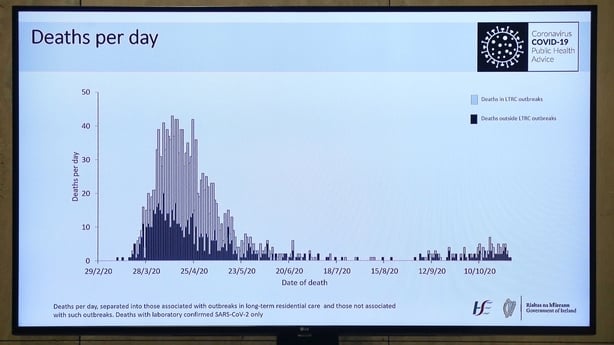
What helped lower transmission of virus in Dublin?
Professor Philip Nolan talked through what happened to lower the incidence rate of Covid-19 in Dublin in recent weeks.
He looked at the daily incidence in the capital - which entered Level 3 restrictions from midnight 18 September.
Prof Nolan said you would expect some change to occur in the one to two weeks after the measures were introduced but "case numbers stabilised almost immediately".
"What that tells us is that people in Dublin began to reduce their levels of contact before the measures was applied," he told the press briefing.
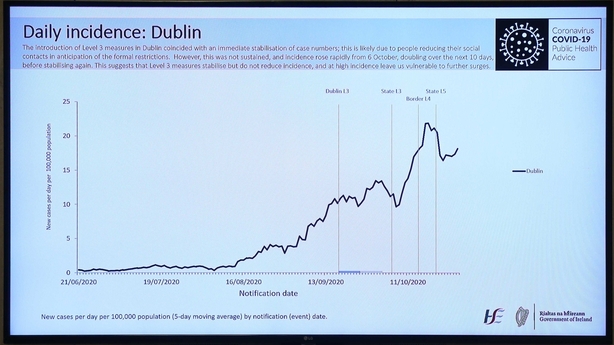
However, he said that was only maintained for about two weeks, for reasons that NPHET still "does not yet fully understand". Case numbers in Dublin then doubled over the next ten days and are only beginning to stabilise again.
Prof Nolan said that one observation that can be drawn from the data is that Level 3 measures "stabilise but do not reduce case numbers" - and if, as was the case in Dublin, case numbers are high, this leaves you vulnerable to another surge.
It's too early to tell why incidence is falling. We can learn from Dublin. Level 3 measures there slowed the rate of growth but did not bring case numbers down; in fact, case numbers rose sharply after two weeks, just as the rest of the country entered Level 3. 3/6 pic.twitter.com/ugy2pEnqp4
— Professor Philip Nolan (@President_MU) October 30, 2020
He said there has been a decrease in the incidence rate of coronavirus in the capital over the past week to 10 days - but that this was not evenly distributed across the population.
While the incidence rate is decreasing among the younger population, it is continuing to increase among those aged over 75.






